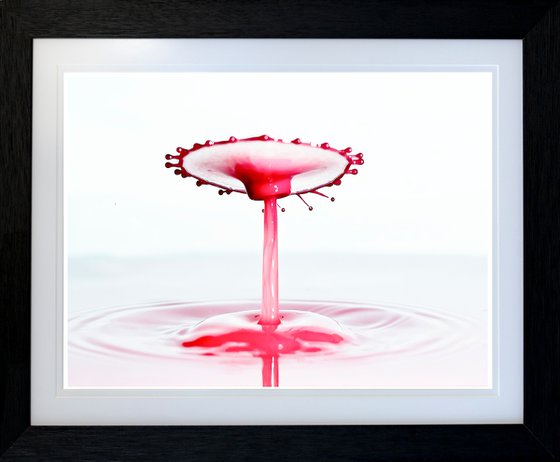- By medium
- By subject
- By budget
- Sales
- Gift cards
- Discover all art
- Artists
- Editors’ picks
- Ideas
Artwork description:
Capturing a photographic image of the exact millisecond that two waterdrops, which are travelling towards each other (one from above & one from below) at a speed that the human eye cannot record; actually collide.
We can see here the ‘Spout’ or ‘Jet’ projecting upwards to meet the next ‘drop’ of liquid before the actual collision..
The ‘Spout’ or ‘Worthington Jet’ is named after the physicist who discovered it in 1908.
Arthur Mason Worthington (11 June 1852 – 5 December 1916 ) was an English physicist and educator.
He is best known for his work on Fluid Mechanics, especially the physics of splashes, and from observing those,
he pioneered techniques of High Speed Photography.
Worthington’s pioneering work would later be overshadowed by the work of Harold Edgerton in the 1930’s.
Improving on Worthington’s techniques, Edgerton’s high speed photography using a stroboscope could produce up to 3000 images per second.
The most famous image that was captured using Edgerton’s technique’s, and easily recognizable & memorized was the 'splash' or 'Coronet' of a milk drop hitting a glass surface. That image has been used extensively in the advertising Industry ever since.
These images are totally unique as it is impossible to replicate the same collision - no two photographs are ever going to be the same...ever!
Given my 'artistic licence' I have named each image to whatever springs to mind when I first see the image - try it yourself and see what you can come up with!
This piece of Art is made from - Archival 310gsm Baryta Photographic Paper, Acid Free Double Mount, Black Solid Wooden Frame, Anti-reflective Acrylic Glazing, Acid Free Mounting Board behind the photograph and a 2mm backing Board. Stretched Brass wire & fixtures for hanging....and not forgetting the passion, love, determination, creativity, imagination and skills required to produce it.
Materials used:
Baryta 300gsm Archival paper, Solid Wood frame, Archival Double Mount, anti reflective clear acrylic
Tags:
#liquid art #waterdrop'Bloody Carousel 2' - Liquid Art (2020) Photograph
by Michael McHugh
£315
- Photograph on Paper
- From a limited edition of 10
- Size: 62.5 x 47 x 2cm (framed) / 45.5 x 30cm (actual image size)
- Framed and ready to hang
- Signed and numbered certificate of authenticity
- Style: Abstract
- Subject: Abstract and non-figurative
Loading
Artwork description
Capturing a photographic image of the exact millisecond that two waterdrops, which are travelling towards each other (one from above & one from below) at a speed that the human eye cannot record; actually collide.
We can see here the ‘Spout’ or ‘Jet’ projecting upwards to meet the next ‘drop’ of liquid before the actual collision..
The ‘Spout’ or ‘Worthington Jet’ is named after the physicist who discovered it in 1908.
Arthur Mason Worthington (11 June 1852 – 5 December 1916 ) was an English physicist and educator.
He is best known for his work on Fluid Mechanics, especially the physics of splashes, and from observing those,
he pioneered techniques of High Speed Photography.
Worthington’s pioneering work would later be overshadowed by the work of Harold Edgerton in the 1930’s.
Improving on Worthington’s techniques, Edgerton’s high speed photography using a stroboscope could produce up to 3000 images per second.
The most famous image that was captured using Edgerton’s technique’s, and easily recognizable & memorized was the 'splash' or 'Coronet' of a milk drop hitting a glass surface. That image has been used extensively in the advertising Industry ever since.
These images are totally unique as it is impossible to replicate the same collision - no two photographs are ever going to be the same...ever!
Given my 'artistic licence' I have named each image to whatever springs to mind when I first see the image - try it yourself and see what you can come up with!
This piece of Art is made from - Archival 310gsm Baryta Photographic Paper, Acid Free Double Mount, Black Solid Wooden Frame, Anti-reflective Acrylic Glazing, Acid Free Mounting Board behind the photograph and a 2mm backing Board. Stretched Brass wire & fixtures for hanging....and not forgetting the passion, love, determination, creativity, imagination and skills required to produce it.
Materials used:
Baryta 300gsm Archival paper, Solid Wood frame, Archival Double Mount, anti reflective clear acrylic
Tags:
#liquid art #waterdrop14 day money back guaranteeLearn more


